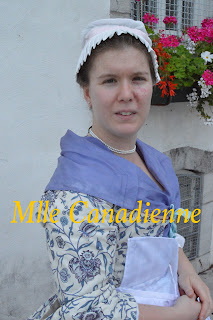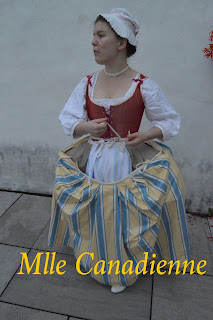Bonjour,
J'ai réalisé que je n'avais toujours pas mis en ligne la raison pour laquelle j'ai fait une séance de photo privée avec mon nouveau costume. Je veux partager les épaisseurs des vêtements féminins du 18ième siècle.
Est-ce qu'il fait chaud là-dedans?
C'est difficile pour quelqu'un qui travaille longtemps sur ses vêtements de ne pas avoir un parti pris en leur faveur, vous conviendrez que ma réponse est par conséquent biaisée. Ma réponse est qu'il fait chaud mais que je ne ressens pas la chaleur de la même manière qu'avec des vêtements 2016. Pour débuter, quand il fait au-dessus de 20°C au soleil, il fait chaud pour tout le monde, historique ou pas. L'avantage des vêtements faits de fibres naturelles, c'est qu'elles respirent, ils ne créent pas ce mini effet de serre des vêtements de polyester qui constituent la majorité de notre garde-robe moderne (je sais il y a maintenant des vêtements synthétiques qui ''respirent'' pour faire du sport). Personnellement, dès que je mets mon corps baleiné, j'ai chaud au tronc et je ne ressent pas réellement les épaisseurs supplémentaires. De plus, les courants d'air venant de la brise sont vraiment appréciés sous les jupons l'été.
Pour un peu démystifier la garde-robe féminine, et faire différent de ce que la majorité des sites, j'ai décidé de vous montrer les différentes épaisseurs sous la forme d'un effeuillage façon 18ième siècle.
Commençons par le tablier...
Crédit photo: Cathrine Davis
Oups j'ai oublié que j'avais un chapeau... Je l'enlève.
On peut mieux voir ma coiffe sans chapeau bergère.
Crédit photo: Cathrine Davis
Et me voilà en simple bonnet.
Oui je porte 3 épaisseurs sur la tête.
Le bonnet qui est le minimum de décence, à mon avis, il fait parti de la coiffure. Les langues sales diront que le bonnet est pour garder les poux chacun pour soi. Comme on peut le voir, le bonnet ne couvre pas entièrement la chevelure ce qui rend cet adage peu valide à mes yeux. La coiffe sert à protéger le bonnet et les cheveux du vent. Le chapeau protège du soleil. Vous aurez compris, à l'intérieur, le seul bonnet peut très bien faire l'affaire.
Crédit photo: Cathrine Davis
Maintenant je peux enlever le tablier.
Crédit photo: Cathrine Davis
Je dénoue les rubans de mon mantelet...
Pour la petite histoire, le mot mantelet désigne une pièce de vêtement qu'on appelle un juste en France à la même époque. Ce que les françaises désignent comme un mantelet est une sorte de petite cape qui porte le nom de capote pour les canadiennes. Je devrais faire un article sur ce vêtement d'extérieur.
Crédit photo: Cathrine Davis
Bon, me voilà en corps baleiné et en jupon. J'ai fait le choix économique de commander le même tissu pour le corps baleiné que pour le jupon en me disant que personne ne verrait jamais les deux pièces ensemble... Et me voilà qui publie des photos des deux ensemble... J'ai un peu honte. mais juste un peu.
Pour faire clair: oui c'est le même tissu, mais à l'époque ces deux pièces de vêtements seraient de tissus différents.
Je retire le mouchoir de cou en voile de soie.
Crédit photo: Cathrine Davis
Je peux maintenant commencer à enlever mon jupon de soie. Si j'ai bien compris la différence entre une jupe et un jupon, pour le 18ième siècle, la jupe est assortie (comprendre même tissu) avec le manteau-de-robe pour donner l'impression d'une robe d'une pièce et un jupon est taillé de la même manière qu'une jupe mais est dans un autre tissu. Pour la description d'un manteau-de-robe, ce sera pour un autre article.
Crédit photo: Cathrine Davis
Attention, les cordons sont dénoués!
Crédit photo: Cathrine Davis
La preuve que j'ai fait les ouvertures de poches un peu juste pour mes panniers, ça coince légèrement. Pour enlever les jupons, c'est plus facile de laisser la gravité travailler!
Crédit photo: Cathrine Davis
Surprise! (oui, une autre) Il y a un jupon en dessous du jupon! Pourquoi? Le jupon jaune permet de cacher les baleines de paniers en créant du volume. Le principe est encore connu aujourd'hui, pour plus de volume, on ajoute des épaisseurs.
Crédit photo: Cathrine Davis
Enfin, on peut voir les fameux paniers qui transforment la silhouette.
Crédit photo: Cathrine Davis
Bon, l'idée originale était de se rendre jusqu'à être seulement en chemise. Cependant, je me sentais vraiment déshabillée, au point d'être légèrement mal à l'aise. À croire que j'étais vraiment imprégnée de l'esprit de la Nouvelle-France. Pour cette raison, je tiens mon jupon de dessous sur les photos de corps baleiné. Le jupon de dessous les paniers est nécessaire, aucun doute là-dessus. Il permet essentiellement une certaine décence en cas de coup de vent car les jupons par-dessus les paniers sont éloignés des jambes.
Crédit photo: Cathrine Davis
La vue de dos du corset, tel que présenté dans un autre billet.
Crédit photo: Cathrine Davis
Voilà un visuel des épaisseurs de vêtements que les femmes du 18ième siècle portaient.
Je voudrais officiellement remercier Cathrine Davis, qui a si bien accompli son rôle de photographe. Merci encore!
Petit extra pour terminer: les jupons s'enfilent par la tête, c'est beaucoup plus facile à poser sur les hanche (et paniers) ainsi!
Crédit photo: Cathrine Davis
Mlle Canadienne
Hello,
I realized that I did not have put on the web the reason why I got a photoshoot in my new merchant clothing. I want to talk about the layers of the woman clothing of the 18th century.
Is it hot inside that clothing?
It is hard to give an answer especially for someone who had work several hours, you'll understand that my answer may not be neutral. So it is warm but I do not feel the warmth in the same way that in modern clothing. First, when it's over 20°C under the sun, it's toasty for everybody historical or not. The benefit of historical accurate clothing is that the clothes are made with natural fibers so they ''breath'' and do create the mini-greenhouse effect of polyester clothing like most of the 2016 wardrobe (I know now there is synthetic sport textile that are made to really ''breath'' during sport). When I put on my stays, I feel that my truck is pretty warm and I do not feel the additional layers. Moreover, air flow from wind is really appreciated under the petticoats during summer.
To demystify the feminine wardrobe and be a little bit different from what others sites and blogs offer, I decided to show the layers by a sort of historical striptease, with the 18th century clothing.
Take off the apron
Crédit photo: Cathrine Davis
Oups, I forgot that I had a hat.
We can see my coif without the ''bergère'' hat.
Crédit photo: Cathrine Davis
Here I am in a simple cap.
Yes, there is 3 layers on my head when I'm outside (almost avery time I wear historical clothing)
The cap is the minimal need for decency, I think it is part of hairstyling. Being mean, I could say that it is to keep the headbugs on everybody's own head.As you can see, the cap doesn't cover the whole hair wich contradict that saying. The coif is to protect the cap and hair of the wind. The hat protect from the sun. Inside, the only cap is decent.
Crédit photo: Cathrine Davis
Now I can remove the apron.
Crédit photo: Cathrine Davis
I remove the ribbons of my ''mantelet''...
For the little story, ''mantelet'' is the french canadian word for a piece of clothing called ''juste'' in France during the same period. And what french called ''mantelet is a reticular little cloak that canadians called ''capote''. It just remind me that I should write an article on winter clothing.
Crédit photo: Cathrine Davis
Here, I am in stays and petticoats. I made the economical choice to command the same fabric for the stays and the outside petticoat, thinking that nobody would never see those two pieces together. And here I am posting pictures of it... I am a little bit ashamed but just a little bit.
To be more explicit: yes it is the same taffetas silk fabric but, during the 18th century those pieces of clothing would have been more likely on different fabrics.
I remove the neckerchief in silk voile.
Crédit photo: Cathrine Davis
Removing the outer petticoat.
Crédit photo: Cathrine Davis
Beware of the ribbons!
Crédit photo: Cathrine Davis
The proof that the opening is a little bit tight for the pocket hoops: it stuck a little. To remove the petticoats, it is easier to let the gravity work for you!
Crédit photo: Cathrine Davis
Surprise! A petticoat under the petticoat. Why? the yellow petticoat hide the boning of the pockets hoops by adding more volume. The principle is still use today: more layers = more volume.
Crédit photo: Cathrine Davis
Finally the pockets hoops are seen.
Crédit photo: Cathrine Davis
So the original idea was to remove clothing until being in shift. But at this point, I really felt like I was wearing underwear, to the soit of being uncomfortable. I may think I was within the spirit of New France. For this reason, I hold my under-petticoat on the stays pictures. Under-petticoat is essential, no doubt of it. It assure a decency in case of wind because the petticoats over the panniers are far apart from the legs.
Crédit photo: Cathrine Davis
Back view, as presented in another post.
Crédit photo: Cathrine Davis
Here you had the visual of all layers of 18th century woman clothing.
I want to officially thank my dear friend Cathrine Davis, who has been such a good and patient photograph. Thanks again!
Little extra: to put on the petticoats, it has to go over the head!
Crédit photo: Cathrine Davis


























